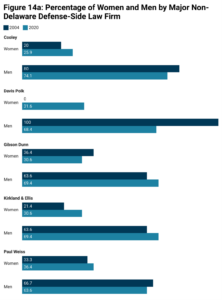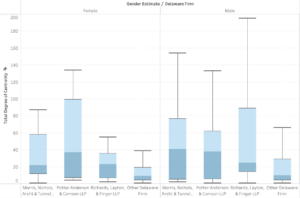Afra Afsharipour is the Martin Luther King, Jr. Professor of Law and Senior Associate Dean for Academic Affairs at UC Davis School of Law, and Matthew Jennejohn is a Professor of Law at Brigham Young University. This post is based on their recent paper, forthcoming in the University of Chicago Law Review.
Law develops through collective effort. A single judge may write a judicial opinion, but only after an (often large) group of lawyers choose litigation strategies, craft arguments, and present their positions. Despite their important role in the legal process, these networks of lawyers are almost uniformly overlooked in legal scholarship—a black box in a discipline otherwise obsessed with institutional detail.
Prior qualitative research suggests that networks are an important source of information, mentoring, and opportunity, and that those professional resources are often withheld from lawyers who do not mirror the characteristics of the typically male, wealthy, straight, and white incumbents in the field. We have a common nickname for the networks that result, which are ostensibly open but often closed in practice: “Old boys’ networks.”
Our article, Gender and the Social Structure of Exclusion in U.S. Corporate Law, is the first academic study that quantitatively analyzes gender representation within a comprehensive network of judges and litigators over a significant period of time. Our study is based on hand-collected data from cases before the Delaware Court of Chancery, the trial court that adjudicates the most—and the most important—corporate law disputes in the United States. We collected seventeen years of docket entries across more than 15,000 matters and 2,700 attorneys as the basis for a massive network. We analyze gender representation among the lawyers involved in Chancery litigation—the “Chancery Litigation Network”—in two ways: (1) straightforward headcounts; and (2) by thinking of the attorneys as actors within a network, which allows us to measure their professional relationships in the field. This network-based approach illuminates men and women’s access to the professional resources that qualitative studies have found to be so important to advancement in the profession.
Analyzing the Chancery Litigation Network produces several important findings, which we summarize below.
A Dramatic and Persistent Gender Gap
First, we find a dramatic and persistent gap between women and men in the network. Men outnumber women in our sample, despite women being almost half of all law students during each of the 17 years of our study. As we show in the figures in this Bloomberg Perspective, women comprised only 23.6% of all attorneys in 2004, the first year for which we collected data. By 2020, that percentage had only increased to 32.9%.
Transforming the docket data into a professional network, we find that men disproportionately occupy the most central positions within the network of Chancery lawyers. Many more men than women are among the most connected—or “central”—attorneys in the Chancery Litigation Network. Furthermore, when we identify the top 50 most-connected lawyers in the network in 2004 and 2020, we find that in 2004, only five of the 50 most central attorneys were women and that by 2020 that number had increased only to 14. Notably, a significant part of that growth comes from the increasing number of women judges on the Delaware Chancery Court over the time period studied.
The Gender Gap Differs by Law Firm
Second, we find that law firm membership and geographical location interacts with gender—women’s positions within the network differs by membership in certain firms or residence in particular geographies. This evidence raises the possibility that some firms or regions may have policies or cultures more conducive to gender equality than others.
To illustrate, we focus here on a sub-sample of major Delaware and non-Delaware firms, measured by the number of matters in which they are involved in the most recent year of the dataset. For both Delaware and non-Delaware firms, it is very rare to find a law firm where women outnumber men in their involvement in Chancery litigations. Rather, we continually observe men outnumbering women from firm to firm. However, some law firms have a gender gap that is smaller than others.
As depicted in the figure below, all of the three major Delaware defense-side firms—Morris Nichols Arsht & Tunnel LLP, Richards Layton & Finger LLP, and Potter Anderson Corroon LLP—have a gender gap. The gender gap closed modestly over the time period studied, but the percentage of women participating in Chancery litigation remained below the overall average for all firms in our dataset. In 2004, the average percentage of women participating from the three major Delaware firms was 12.6%, while the percentage of women across the entire dataset for that year was 23.6%. In 2020, the average percentage of women at those three firms increased to 22.1%, which is still well below the overall average of 32.9%.
We observe similar patterns at the major non-Delaware defense-side law firms that are involved in Chancery litigation. As reported in the figures below, all ten firms have a gender gap, where men outnumber women. However, compared to the three major Delaware firms analyzed above, these non-Delaware firms tend to have greater percentages of women on their litigation teams. Overall, the average percentage of women across these ten firms was 32.8%, which was greater than the average for the three Delaware firms reported above and nearly the same as the average among all firms in the dataset.
We then analyze how attorneys’ network centrality—the number of connections attorneys in the network of Chancery litigators have—differs across the major firms. Like the participation statistics above, we find that the distribution of network links among men and women differ between firms. Interestingly, however, the patterns here do not necessarily track the law firm patterns observed above. In that respect, the network analysis reveals things that are otherwise obscured by straightforward headcount statistics.
We focus here on the distribution of network links in 2020 among men and women for the major Delaware firms, Morris Nichols, Potter Anderson, and Richards Layton. As depicted in the figure below, those firms’ distributions of network links among their attorneys are not equal. Richards Layton, for instance, exhibits a particularly stark difference between women and men, with the most connected men at that firm having more than 2x the number of connections in the network than women. (Note, however, that in 2020 Richards Layton had the highest percentage of women participating in Chancery litigation (28.85%) compared to the other major Delaware firms.) We see a similarly interesting relationship at Potter Anderson, though the interplay is in the opposite direction. In 2020, Potter Anderson had the lowest percentage of women participating in Chancery litigation—less than 10% of its total attorneys in this market. However, as the figure below shows, the centrality of Potter Anderson’s women and men is most evenly balanced.
Figure 15: Total Degree Centrality by Estimated Gender and Attorney’s Law Firm, 2020
The Gender Gap Differs by Geography
Third, examining geographic trends reveals similar patterns. There is a gender gap in all the major geographic locations we study—men outnumber women in California, Delaware, New York, and all other jurisdictions in our dataset. That gender gap also recedes modestly over time. In jurisdictions such as California and New York, the share of attorneys who are women increased from 2004 to 2020. Interestingly, our data captures the relative decline of Delaware lawyers in the share of attorneys involved in Chancery matters—the percentage of both women and men based in Delaware actually falls from 2004 to 2020, though the decline is slower among women than men.
Analyzing Individual Litigators Reveals Personal Networks Dominated by Men
Finally, as we drill down into the networks of individual women, we find that men regularly dominate the networks of female Chancery litigators—even the most highly connected women in the network. It is not unusual, particularly during their early careers, for women to work only with men. Relatedly, the men in the personal network of a woman typically enjoy thicker connections to one another, forming a dense gendered sub-network to which women are only loosely connected. Furthermore, we find that the networks of individual attorneys change significantly from year to year. When a woman attorney works with women in one year, those women rarely repeat in her personal network the following year. Relatedly, while men also experience significant turnover in their personal networks from year to year, one thing is always constant for them: Men consistently encounter a large number of other men from matter to matter. That familiarity gives men a potentially valuable social anchor in a volatile professional environment, a benefit unavailable to women litigating in Chancery.
Looking Ahead
Our findings set the stage for subsequent research to test the connection between gender representation in litigation networks and discrete outcomes, such as the incidence of bias in judicial opinions. It also demonstrates how subsequent research can incorporate network structure into quantitative and qualitative studies of not only gender bias but also other forms of inequality in law. With respect to policy, it provides the necessary first step to crafting normative interventions that improve equitable access to professional resources by making networks more empirically concrete. The persistence of the gender gap highlights the inadequacies of some existing policies to reduce gender inequality, while it also suggests what might be more effective going forward. With that added clarity, the network approach allows us to calibrate remedial options available to bar associations, law firms, and individual attorneys, leaving no level of the institutional setting untouched.
 Print
Print


